
Conversation

🥳 Feedback Received!
Thanks for taking a moment to share your thoughts — it genuinely helps us make each chapter sharper.
What happens next:
- Your feedback goes straight to our product team.
- We’ll use it to refine lessons, clarify examples, and make the program even more useful.
Appreciate you helping make this program better for everyone.
Ready for your next challenge? 👇
Acquired Link Building Activities
Search ads
For any new site, getting traffic (much less links) to newly published content can be an uphill battle. A strategy worth testing to accelerate this is running search ads to the page you want to build backlinks to. Since search ads appear at the top of SERPs, running ads can help get these pages more traffic—and potentially more links.
Why this can work:
- Most companies running ads are competing for keywords with strong purchase intent, usually directing users to sales pages.
- This tactic does the opposite: going after keywords with low purchase intent (which tend to be cheaper and less competitive) and directing users to a non-salesy piece of content.
The content that’s most likely to succeed in this strategy tends to be comprehensive and educational, like a long roundup of statistics. The idea here is that a reporter or blogger in need of this information would search for the target keyword and click on your content, which, thanks to Google Ads, appears at the top of SERPs. Then they’d link to it.
You can learn about how to set up Google Ads in our Search Ads unit. Here’s an example of companies using this strategy to target the phrase “remote work statistics.”
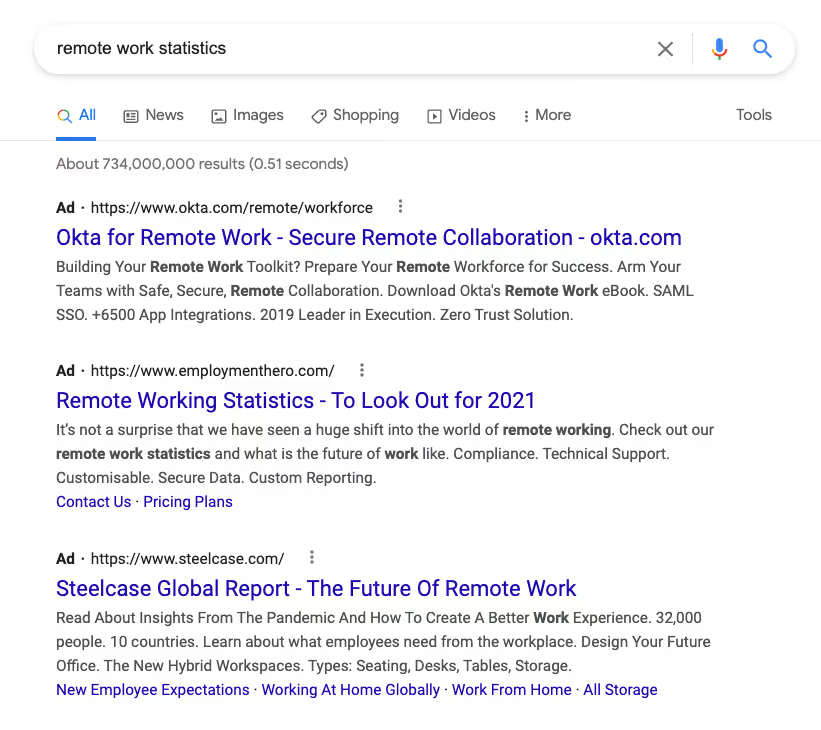
This isn’t a foolproof strategy, but something to test with a live ads campaign for 1-3 months. You shouldn’t expect to get backlinks immediately, as writers may go through a long editorial process before their content gets published.
So after your ad campaign finishes, check your backlinks using Ahrefs. Then check again after three months for any additional backlinks.
It’s impossible to find out the true impact of your search ad and how many links it earned. But some writers who linked to your page may have simply copied and pasted your page’s URL, even including its Google Click ID (GCLID). This is a part of your ad URL that, if included in a backlink, indicates that a user did indeed link to your page from its ad.
Here’s how to check whether your ad URL has any backlinks:
- Search your website in Ahrefs’ Site Explorer.
- Click on the number under Backlinks.
- In the Backlinks results page, filter for backlinks that include “gclid”. We’ve done this with Employment Hero, one of the websites that created an ad for “remote work statistics” in our earlier example.

Looking through the backlink results, it’s clear Employment Hero has used this strategy for several non-sales pages—and it’s worked! The fact that backlinks include the GCLID parameter indicate people are linking to the ad page. Still, this doesn’t paint the full picture of how many links your ads have gotten, because some writers will clean up the URL before linking to it in their content.
While this strategy costs money, it may generate links for a lower price than you’d otherwise pay with a professional link builder. For example, if you spent $500 on Google Ads and discovered four links to your target page, that’s about $125/link—much cheaper than services charging $300-$500 per link.
Cold outreach
One of the most straightforward and yet difficult ways to get a backlink to your content: asking for it. This is usually done through cold email outreach to webmasters and influencers. It’s most effective when you have:
- Amazing content: Content that’s clearly superior to other existing content about the same topic, e.g., because it provides more examples or detail.
- Connections to other webmasters: You know other people that create content in your niche.
Without either, cold outreach often doesn’t have very good ROI. Personalized outreach can lead to better results, but this is time-intensive. Automation platforms like BuzzStream make it possible to send hundreds of customized emails for link building, but still, the success rate of these is usually quite low.
The skyscraper technique, a strategy named by Brian Dean, relies heavily on creating excellent content, regardless of your connections with other sites. Using this technique, companies create better content than what already exists—for example, producing a more thorough and detailed guide than a leading competitor’s. Then they reach out to sites linking to the existing, inferior content to ask for a link.
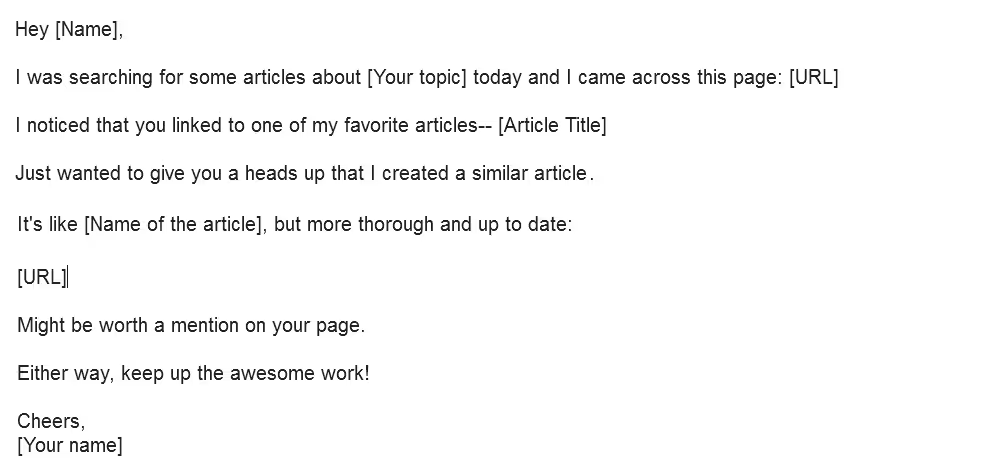
Though this strategy can work, there’s no guarantee. If the existing content they’ve linked to is still helpful, some of the sites you contact simply won’t be inclined to switch links.
This reflects one of the biggest challenges of cold outreach as a link-building strategy: it often comes across as one-sided. Many webmasters understand that giving a link to whoever’s reaching out benefits the other party more—so you generally need to give more reason as to why they should link to your content.
Broken link building is a strategy intended to do exactly that. Using this tactic, you identify web pages that are relevant to your content and have broken links—links that direct to error pages because the original page no longer exists. You then reach out to the webmaster to suggest linking to your resource, since the broken link provides no value to readers.
Example: If a website had a broken link to a now-deleted resource about project management, you could suggest replacing it with a link to your guide about project management best practices.
Here’s what a broken link building email might look like.
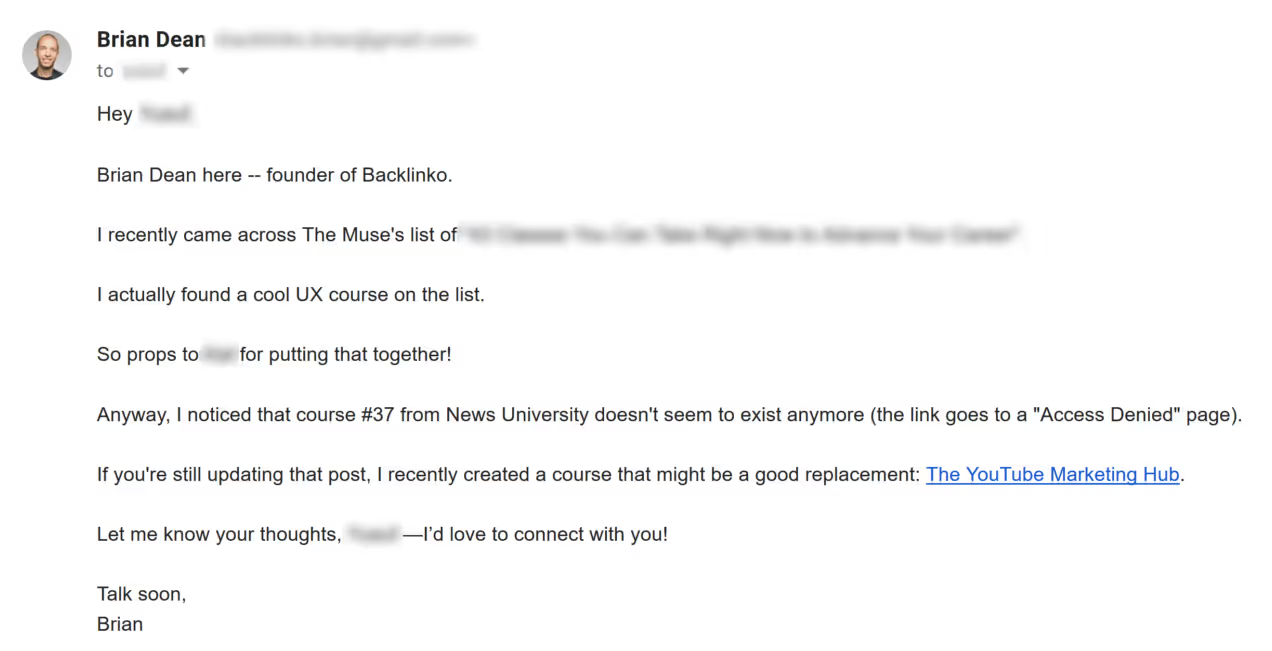
The difficulty with this strategy is identifying broken links about topics that your website also covers. We advise using Ahrefs:
- Look up similar websites in your industry, like your competitors, in Site Explorer.
- Select the Best by links option under Pages in the sidebar.
- At the top of the results, filter for “404 not found” in the HTTP code dropdown. Here you’ll see broken URLs on the website you’ve searched, plus the number of websites that link to this broken page (under Referring domains).

Because these pages are broken, you won’t know what kind of content they offered—but the URL slug often gives a big clue. For example, in the screenshot above, the second result was most likely a blog post about sales copywriting techniques relying on human psychology.
- Look for URLs that cover topics you also have content about. So if you also have a guide about sales copywriting techniques on your site, it may make sense to target any websites that link to the broken post mentioned earlier.
- Click the number under the Dofollow column in the row of the broken link you want to target. This will show you a Backlinks report listing the pages that currently link to that URL (which actually leads users to a 404 error page) and do not have a nofollow tag.

These are the sites you could reach out to and suggest your content as a replacement for. Not all sites will be a good fit—you’ll have to look at each page and the context (also shown under the Anchor and backlink column) to see which make sense to contact. Avoid reaching out to sites in another language or that are clearly spammy (for example, they have a low DR and use keyword-rich anchor text).
- It’s worth exporting this data as a spreadsheet to track which sites to reach out to. You can also use it to compile the contact information for each site (use a tool like Hunter.io for more efficiency).
The broken link strategy can work, but there’s no guarantee. Sometimes instead of linking to your suggested page, webmasters simply remove the broken link.
...Which is why you might instead try offering something of value.
Note that according to Google’s guidelines, explicitly offering something in exchange for a link counts as a link scheme. So when using this strategy, people generally take a no-strings-attached approach, offering something of value but not asking for an outright trade.
For example, here’s an email pitch that not only gives valid reasons for why a link to their content would make sense, but also offers several goodies—regardless of whether the recipient does give a backlink.

For this strategy, here’s how to find websites to reach out to.
- In Google, search for your target keyword. The top search results are likely competitors. Their content may resemble yours, although ideally, yours should be better. (Otherwise, sites would rather link to whatever’s ranking at the top of SERPs.)
- Choose one of the competitor results—one that your content is clearly superior to. You’re going to be suggesting that other websites link to your page instead of this competitor.
- Enter its URL into Ahrefs’ Site Explorer. Click on the number under Backlinks.

- A list of pages that link to this URL will appear. Look at each page and the link context (shown under the Anchor and backlink column) to see which sites are worth reaching out to.
Whether you use the broken link building strategy or offer something more tangible in your outreach, you also need to write good outreach emails. Our Cold Outreach module teaches how to write more effective emails for the purpose of lead generation, but you can apply the same principles to outreach emails asking for a backlink.
Guest posting
Guest posts are blog posts written for another company’s website, often with a backlink to the author’s site. There may be a link in the author bio as well as a link in the guest post’s actual body.
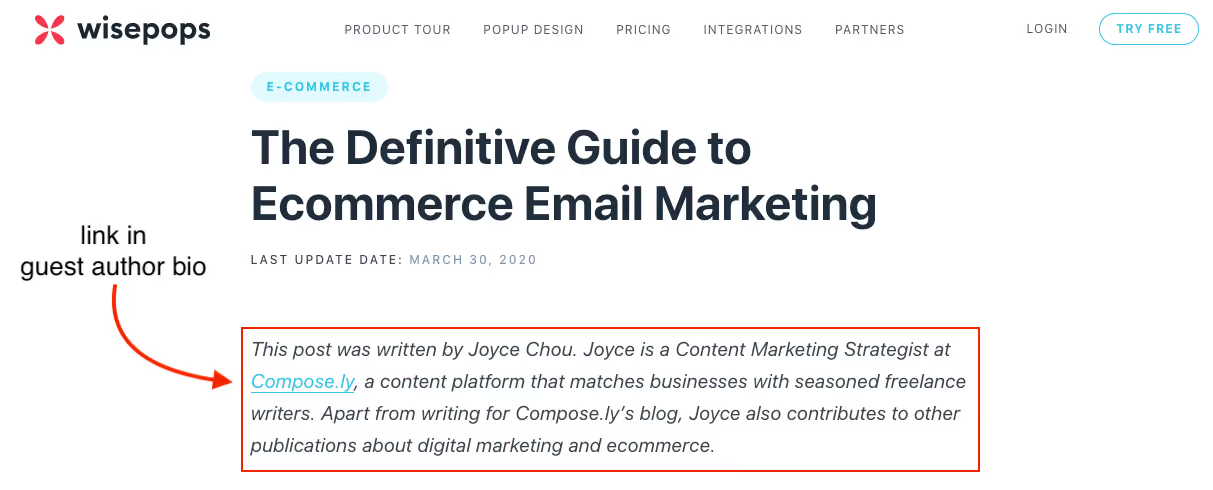
Many SEO strategies focus on guest posting on reputable, high-authority websites related to their industry. These sites drive stronger link equity as well as relevant traffic.
For example, if your product is an accounting software, it would make sense to write a guest post about small business accounting tips for a business site. You could include a link to your homepage as well as a related blog post on your site for interested readers that want to learn more.
While guest posts help establish your company’s authority, getting them published is often a time-consuming process that involves:
- Searching for relevant sites to guest post on (we walk through this process in our Content Distribution project)
- Pitching article ideas, often via email
- Drafting and editing the guest post
- Additional edits or revisions based on feedback from the other site
To find relevant sites that accept guest posts, Google your industry, plus keywords about guest posting. For example:
- Startup “guest post”
- Startup "write for us"
- Startup "contributor guidelines"
- Startup “writing guidelines”
Use quotation marks around the keywords you only want exact matches for. The phrases above are often used in the context of guest posting.
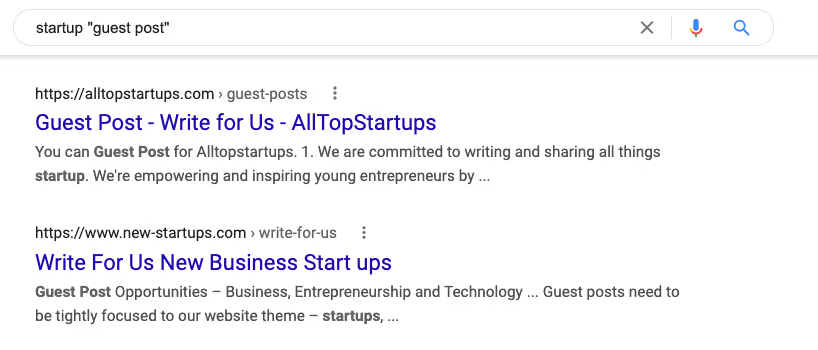
Most sites have specific guest posting guidelines that detail what kind of content they’re looking for; not all may be a good match for your site. Read through these guidelines and also look up each site in Ahrefs to find out their DR. Prioritize guest posting on sites that have a higher DR, ideally at least 50. (Use the spreadsheet template from our Content Distribution project to track these guest posting sites.)
Once you’ve identified relevant sites to guest post for, follow their process for pitching or submitting content. Oftentimes websites ask for a detailed pitch via email or through a form, with very specific instructions like what to write in the subject line. Follow these instructions closely—otherwise, your guest post pitch may be ignored.
In this way, cold outreach is also a part of guest posting, though you’re offering to write an article for another website’s audience rather than simply asking for a backlink. The same principles hold here: you’ll get the best results with more personalized emails that clearly convey how you, or your post, will bring value.
Many sites also ask for samples of your other content to judge whether or not to accept a guest post from you. Unless you’ve already published other content online, send over well-written blog posts from your site that relate to the guest posting site.
Over time, successful guest posting has a snowball effect for your own credibility as an author. If you get published on any reputable sites like HubSpot, include them in your guest post pitch.
Here’s an example of a successful pitch email.
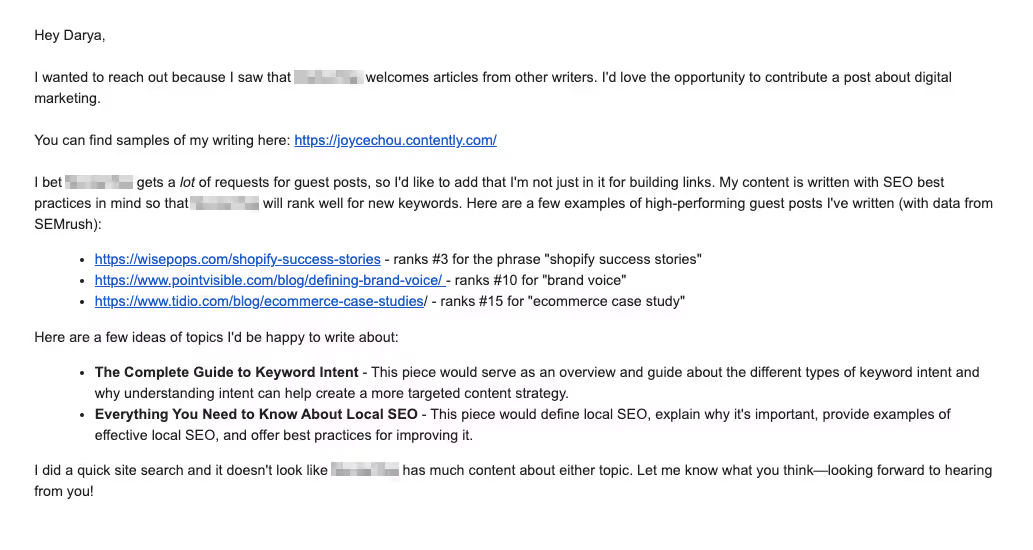
What makes this pitch effective?
- Besides providing writing samples, it also offers SEO data about how the writer’s past guest posts performed. Webmasters know that people want to write guest posts for a link—but that doesn’t mean the guest posts they receive are always good. Including data from Semrush gives the guest post editor more confidence that this writer can provide real value to their site.
- The writer makes it clear they researched the guest post site with their suggested topics. This comes across in the line, “I did a quick site search and it doesn’t look like your site has much content about either topic.”
Guest posting can be time- and resource-intensive—but done well, it gets more link equity and referral traffic for your site. You may also benefit from networking with other companies; webmasters pleased with your guest posts might invite you to submit another guest post later on.
A few tactics for making your guest posting strategy more efficient:
- Leverage any existing connections for a guest post first. If you know people at other companies in your niche, ask about writing an article for their site. Or, ask any link partners you’ve worked with if you can submit a guest post.
- Outsource your guest posts to skilled writers. Once you’ve successfully pitched guest post ideas, hire freelance writers in your niche to draft them. Edit as needed and then submit them. Doing this lets you focus on the pitching process to get more articles published on other sites.
- Write guest posts about topics already covered by your long-form articles. This strategy saves time on ideating and researching completely new topics to write guest posts about. For example, Ahrefs creates detailed, long-form guides for its own blog—then creates shorter guest posts using the same research to pitch to other sites.
HARO
Major publishers and outlets use Help A Reporter Out (HARO) to get quotes from industry experts for their articles. (There’s also Help a B2B Writer—the same concept, but with a focus on B2B industries.) You can sign up as a source and contribute your insights to get cited with ideally, a link to your site—although there’s no guarantee.
Signing up as a source will get you regular HARO emails with journalist queries like these:
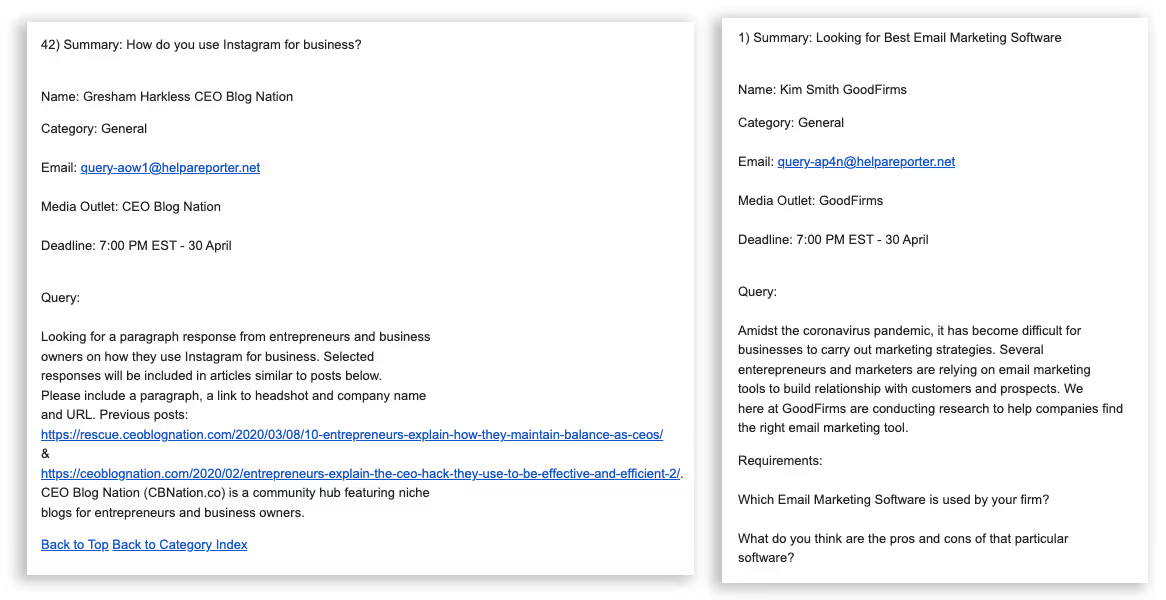
Queries relevant to your product make good opportunities for getting a backlink from an established website—but you need to write clear, thoughtful responses to increase your chances of being quoted. The goal isn’t to sell your product; it’s to get a brand mention and link from a high-authority site.
The best way to use HARO:
- Sign up for queries from industries that relate to yours. (Signing up for irrelevant industries will mean more emails and queries to filter through.)

- Selectively choose queries that you’re qualified to answer or can offer a genuinely valuable perspective on. Don’t answer queries that are only loosely connected to your product. Journalists using HARO receive dozens of responses and tend to prefer quoting only the most relevant sources.
- Set up a Google alert for your name as well as your brand’s. Journalists don’t always share their published piece with the people they’ve quoted, so a Google alert brings any newly published content quoting you or your company to your attention.
- Keep a running doc with all of your HARO answers. Multiple journalists may seek quotes on the same subject, so you can save time writing by repurposing and tweaking previous responses.
- Use a spreadsheet to track the queries you’ve answered, when you responded, the journalist submitting the query, and the publication a query is for.
- You may see repeated queries from one journalist—if they’ve cited you before, it’s worth mentioning this in your email. Work on building a rapport with journalists; if they’ve enjoyed working with you, they may reach out to you for future queries.
Here’s an example of a successful HARO response.

Not all HARO responses need to be so long, but effective responses are generally:
- Detailed. They thoroughly answer the question asked by the journalist.
- Novel. They provide new and meaningful insight that readers may not already know or expect about a topic.
- Formatted for clarity. They’re easy to read because they use line breaks, bullet points, and numbered lists. They may also emphasize key points with bolding or underlining.
Remember to include a line about who you are and why your response matters—you might relate this to your company. It’s OK to give a quick explanation of what you do, but keep this short. The bulk of your email should be a response to the HARO query.
Online communities
Online communities are a potent source for acquiring links—specifically marketing communities where most members have a basic understanding of SEO. Besides getting links, these places are great for networking with other brands and potentially grabbing organic backlinks in the future.
A few places worth joining:
To find more, ask around your network. Search Facebook and Google for free marketing groups.
Because these communities understand the importance of link building, their members are often more transparent about what they’re looking for. You’ll generally see two types of posts in these communities:
- Link suggestions: When someone shares a topic they’re writing about and asks for relevant resources to link to.
- Link partnerships: People looking to build either one-time or ongoing link building relationships with marketers from other sites.
Here’s an example of a post asking for link suggestions.

A request for link suggestions is an invitation to send over any links related to the requester’s topic. Write a quick blurb about why your link would be a great resource for their article to include; then send it through an email or Slack or Facebook message.
Alternatively, some people also collect quotes and links by setting up a Google form, like so:
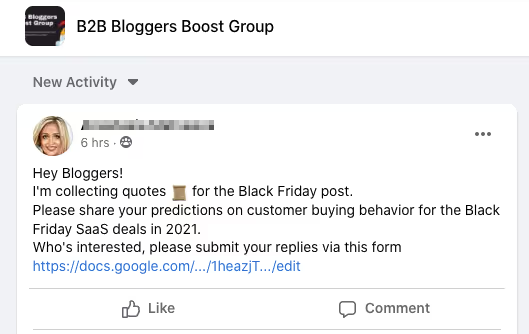
Link partnerships are more involved—and they fall into an iffy category between white hat and black hat SEO. Think of them as an amplified form of guest posting.

When you enter a link partnership, both parties are expected to deliver links from other sites. One way to understand how this works:
- Site A and Site B agree to a link partnership.
- Site A publishes a guest post on Site C. The guest post links to Site A as well as Site B.
- Site B publishes a guest post on Site D. The guest post links to Site B as well as Site A.
- Neither Site A nor Site B link to one another on their own sites.
These aren’t direct link trades, although they’re similarly transactional with the goal of building links for the two partner sites involved. Some companies are involved in multiple partnerships at once, creating a wide network of link builders that all lean on one another.
Compared to traditional guest posts, link partnerships are more efficient. If you have multiple link partners, one guest post could net as many backlinks as you have link partners.
But these partnerships require extra coordination—both you and your partner must communicate which of your content you’d like to build links to (your “target pages”). Then you must find guest posting sites where you can write about a topic that naturally links to not just your site, but also your partner’s.
Marketers often use a shared spreadsheet and email to track each partner’s target links and successful guest posts.

Whether you go for link suggestions or partnerships or both, here’s how we advise starting off in online communities:
- Rather than making your own post, first look for posts from marketers working in your niche.
- Check other marketers’ sites using Ahrefs. Also take a look at their actual website—is their content good? Would you find value in it as a consumer?
- Respond to posts by marketers working with a high-DR site (>50) in an industry that relates to yours. Be polite and cordial.
- Besides getting backlinks, work on cultivating relationships with other marketers and webmasters. This will open the door for other cross-promotion opportunities later on.
A warning: Not all marketers in these communities follow ethical SEO practices. Avoid those that make requests that blatantly violate Google’s guidelines, like asking for reciprocal links.


